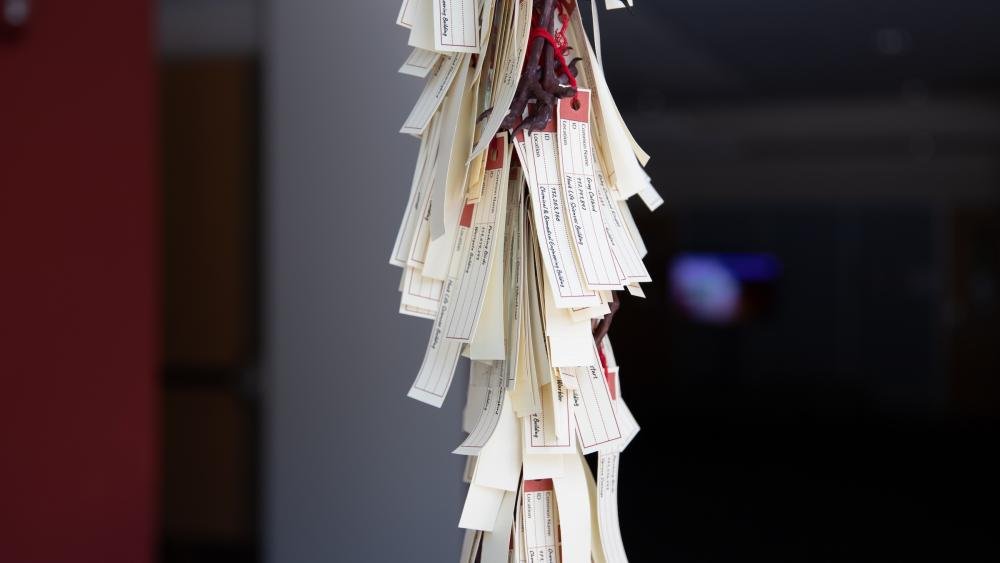UNIVERSITY PARK, Pa. — “Synergies in Art and Science,” an art exhibition showcasing collaborations at the intersection of microbial science and artistic innovation, will be on display at the Penn State College of Arts and Architecture’s Borland Project Space, 125 Borland, Oct. 28–Nov 15. The exhibition, curated by adjunct researcher Cynthia White, expands on some of the work previously shown in spring 2024 in conjunction with the One Health Microbiome Center Biannual Symposium.
The exhibition was organized by the College of Arts and Architecture’s Arts and Design Research Incubator, where White is an adjunct research associate, and the One Health Microbiome Center, for which she is on the executive committee. The Arts and Design Research Incubator has been part of the center since the center’s inception in 2017.
Exhibiting arts and architecture faculty include Andrew Hieronymi and Cristin Millett in visual arts, and Benay Gürsoy, Felecia Davis, Pep Avilés and Laia Celma inarchitecture, as well as 2024 bachelor of fine arts art alumna Marianna Renda. Work by Kathy High, professor of video and new media and a pioneer bio-artist from Rensselaer Polytechnic Institute, will also be featured.
“For arts and architecture, the ‘Synergies’ exhibition is a fantastic way to showcase our innovative artistic practices and how our arts researchers explore scientific concepts in creative ways, by employing scientific methodologies like introducing biological materials and scientific data into artistic practice,” White said.
Exhibited projects:
CONTACT (work in progress)
Andrew Hieronymi
Interactive game that will mimic and predict soil microbial interaction, developed by Hieronymi in collaboration with Couradeau lab, an ecosystem science and management lab directed by Estelle Couradeau, Penn State assistant professor of soils and environmental microbiology.
Placen-Tech (2024)
Cristin Millett
Interactive mixed-media acrylic sculpture with live feed of a corrosion-cast placenta, created by the Ex-Utero Collective, led by Millett. The overall project, “Ex-Utero: A Sculptural Exploration of Ectogenesis,” is a provocative examination of human reproduction and the extraordinary possibilities of ectogenesis. It merges scientific inquiry with artistic methodologies to investigate the human placenta as a transient and temporary organ.
MycoKnit: Cultivating Mycelium-based Composites on Knitted Textiles for Large-Scale Biodegradable Architectural Structures (2023)
Benay Gürsoy and Felecia Davis, Co-Principal Investigators
This project explores using mycelium-based and knitted textiles to form a sustainable building material. The creation of “MycoKnit” as a concept began through a collaboration between Davis’ SOFTLAB and Gürsoy’s ForMat Lab to create a lightweight material for biodegradable architectural structures.
LEED, Uncertified (2023)
Johanna Beam and Marianna Renda
Beam, doctoral student in avian evolution in the Toews Lab, and Renda, who received a bachelor of fine arts in art, sculpture emphasis, in 2024, visited each other’s curiously differing workspaces to exchange ideas and learn more about each other’s practice. The task was to create an artwork that would heighten awareness about the concerning number of bird strikes caused by windows in the built environment, especially on the University Park campus. This piece is an outcome of their extensive conversations about avian biology, ecology and built environments.
Soil Samples (2022)
Pep Avilés, Laia Celma, Cynthia White and Mary Ann Bruns
This photographic series is from a larger body of work called “Sentinel Lands: The Geospace of Mine Fires” (2022), which explores the long-term spatial and ecological consequences of extraction economies and their impact on climate change and the built environment. The project was site specific to Centralia, Pennsylvania, where a devastating mine fire changed the course of a community and the local ecology where the fire still burns.
OKPoopid (2017)
Kathy High
“OkPoopid” is a promo video for a new app where participants can line up speed dates with potential fecal donors for DIY at-home fecal microbial transplantations — making feces as a therapy available to the general public as part of the gift economy.
The pieces by Hieronymi and by Beam and Renda are the result of a semester-long engagement between the College of Arts and Architecture and the One Health Microbiome Center, which is housed in the Huck Institutes of the Life Sciences.
More about the exhibit
“The exhibiting faculty are arts researchers pushing boundaries by experimenting with new techniques and technologies to better understand scientific landscapes, create new materials and provoke new models of thinking about the world we live in,” said White, noting their work is made possible by open engagement with science researchers who are tackling global issues around human health, agricultural health and environmental health. “At Penn State, we are fortunate to have the premier, internationally recognized One Health Microbiome Center on campus and an eagerness from the dynamic and diverse group of scientists willing to pursue these collaborations. It speaks to both scientists and artists that they are receptive and curious to explore problems together and create a new visual and cultural language.”
“Synergies in Art and Science” was curated by Cynthia White, with special thanks to Nichole Ginnan, Cody Goddard, Dina Constantinides, the Arts and Design Research Incubator, College of Arts and Architecture and One Health Microbiome Executive Committee.





